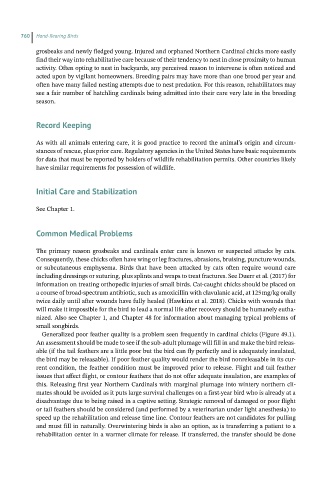Page 757 - Hand rearing birds second
P. 757
760 Hand-Rearing Birds
grosbeaks and newly fledged young. Injured and orphaned Northern Cardinal chicks more easily
find their way into rehabilitative care because of their tendency to nest in close proximity to human
activity. Often opting to nest in backyards, any perceived reason to intervene is often noticed and
acted upon by vigilant homeowners. Breeding pairs may have more than one brood per year and
often have many failed nesting attempts due to nest predation. For this reason, rehabilitators may
see a fair number of hatchling cardinals being admitted into their care very late in the breeding
season.
RecordKeeping
As with all animals entering care, it is good practice to record the animal’s origin and circum-
stances of rescue, plus prior care. Regulatory agencies in the United States have basic requirements
for data that must be reported by holders of wildlife rehabilitation permits. Other countries likely
have similar requirements for possession of wildlife.
InitialCareand Stabilization
See Chapter 1.
CommonMedicalProblems
The primary reason grosbeaks and cardinals enter care is known or suspected attacks by cats.
Consequently, these chicks often have wing or leg fractures, abrasions, bruising, puncture wounds,
or subcutaneous emphysema. Birds that have been attacked by cats often require wound care
including dressings or suturing, plus splints and wraps to treat fractures. See Duerr et al. (2017) for
information on treating orthopedic injuries of small birds. Cat‐caught chicks should be placed on
a course of broad‐spectrum antibiotic, such as amoxicillin with clavulanic acid, at 125 mg/kg orally
twice daily until after wounds have fully healed (Hawkins et al. 2018). Chicks with wounds that
will make it impossible for the bird to lead a normal life after recovery should be humanely eutha-
nized. Also see Chapter 1, and Chapter 48 for information about managing typical problems of
small songbirds.
Generalized poor feather quality is a problem seen frequently in cardinal chicks (Figure 49.1).
An assessment should be made to see if the sub‐adult plumage will fill in and make the bird releas-
able (if the tail feathers are a little poor but the bird can fly perfectly and is adequately insulated,
the bird may be releasable). If poor feather quality would render the bird nonreleasable in its cur-
rent condition, the feather condition must be improved prior to release. Flight and tail feather
issues that affect flight, or contour feathers that do not offer adequate insulation, are examples of
this. Releasing first year Northern Cardinals with marginal plumage into wintery northern cli-
mates should be avoided as it puts large survival challenges on a first‐year bird who is already at a
disadvantage due to being raised in a captive setting. Strategic removal of damaged or poor flight
or tail feathers should be considered (and performed by a veterinarian under light anesthesia) to
speed up the rehabilitation and release time line. Contour feathers are not candidates for pulling
and must fill in naturally. Overwintering birds is also an option, as is transferring a patient to a
rehabilitation center in a warmer climate for release. If transferred, the transfer should be done

